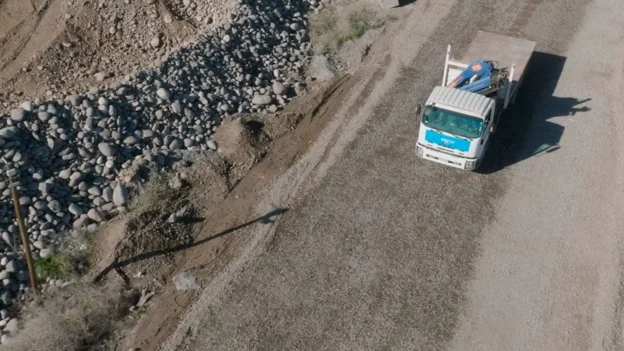The new Sótero del Río Hospital becomes the scene of a pioneering test: a hybrid truck crane, which has been modified to operate with a dual system that integrates diesel and green hydrogen. An initiative that is part of a broader strategy of Sacyr Ingeniería e Infraestructuras to reduce CO₂ emissions and promote clean technologies in its projects.
The hybrid truck crane project
From Santiago, a real field experience has been launched. In collaboration with AndesH2, a company with experience in Colombia and Chile, Sacyr implemented a dual combustion system in one of its vehicles. The technical modification was designed in Italy specifically for this model of truck crane and allows injecting 15% hydrogen into the fuel mixture.
Preliminary results, using 4 kg of hydrogen under controlled conditions, have shown an improvement in energy efficiency and a decrease in diesel consumption. The objective is to achieve a progressively cleaner fleet without compromising the operability at construction sites.
The Sótero del Río Hospital, which is projected to become one of the largest health centers in Latin America, has been recognized for its Zero Waste certification. This distinction is complemented by the approach of Sacyr s focus on testing technologies that mitigate environmental impact during the construction phase. The incorporation of green hydrogen in heavy machinery is part of this commitment.
Rodrigo Fernández, Construction Manager of Metro Line 7 for Sacyr in Chile, explained that this test is aimed at validating how the fleets could evolve towards low-emission configurations. He also mentioned that this transition also contemplates other equipment, such as hopper trucks or backhoe loaders.
The technology implemented represents a challenge to current transportation standards. One of the advances will be the homologation of the truck for circulation on public roads, which is currently being processed with the Chilean Ministry of Transport and Telecommunications. At the same time, a specific safety plan is being developed to operate these hybrid systems in real work environments.
Etienne Valdés, in charge of R&D at Sacyr Chile, emphasized that this pilot will serve to evaluate the concrete benefits of alternative fuels, beyond their specific application in this project. The knowledge obtained could be scaled up to other worksites and countries where the company operates.
This project is an intermediate stage on the road to completely emission-free fleets. While 100% electric or pure hydrogen technologies are being consolidated, hybrid solutions such as the one used here allow progress to be made with less environmental impact. The experience gained at the Sótero del Río Hospital will serve as a basis for future strategic decisions in sustainable infrastructure.
Follow us on social networks and don’t miss any of our publications!
YouTube LinkedIn Facebook Instagram X (Twitter) TikTok
Source and photo: Sacyr


